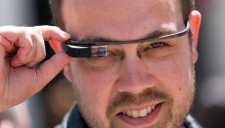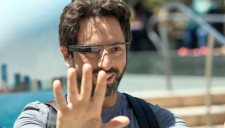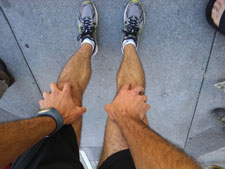
Apple’s rivaling visionaries in Mountain View are about to go beyond of what’s making sense today: Google is pitching its Project Glass eyewear as the next step for mobile photography. It may be the next very big thing.
Well Google has already patented the design of Project Glass, the augmented reality (AR) spectacles. They have shown off a bunch of new photos to prove the technology works. The whole series is posted here on Google+. And check out the Google Glass Walk.
Eyeglass photography is the next best thing to seeing with your own eyes. Augmented reality glasses see exactly what you see while a mountable device serves as a capturing, storing and transmitting device. And it’s not even an eyeglass. The prototype’s an augmented reality head-mounted display (or HMD) is a frame without glasses.
An all-in-one device. Camera, phone, daily planner, you name it, everything in one. But first it’s about photography.

You’ve seen all the fancy sci-fi movies with heroes’ reality eyeglasses projecting a computer screen onto the field of view. Some fancy carmakers already display cruising and vital information on the windshield using a head-up display.
Now Google is stepping up Project Glass. They see “Glass as an evolution of cell phone photography”, said Max Braun, a tech lead on Project Glass who took the stage at the conference.
Project Glass talks about how the augmented reality glasses could change photography. And Google showed off a bunch of new photos to prove it.

Braun pointed out that the prototype’s camera has a wide angle attempting to mimic the user’s actual field of view.
Still, how exactly the photo-taking mechanism works is unclear and they won’t tell. It’s suggested that the user taps the side of his glasses to initialize the camera. But given that some of Google’s sample photos were taken while the user’s hands were occupied the device may have a hands-free mechanism as well. Voice control with the coolest optical interface is the easiest guess.
Don’t laugh, but even eye control is a possibility.
It’s a technology already in use, such as for patients with Lou Gehrig’s Disease (ALS), a progressive neurodegenerative disease that affects nerve cells in the brain and spinal cord. In the end only the eyes are able to move. Should the progression of ALS impair a person’s ability to speak a portable eye-controlled assistive technology device gives users a tool to keep them in touch with their world.
There is still way to go. According to Brin the prototypes that Googlers are testing “rough off the lab floor.” They’re not even considered alpha or beta devices. Still, watch the promo video “Project Glass: one day…” Plan your day, how’s the weather, communicate and take pictures via your glasses:
Google announced Project Glass after months of rumors in April 2012. Project Glass is part of the Google X Lab at the company, a secret facility run by Google thought to be located somewhere in the Bay Area of Northern California. Google X Lab has worked on other futuristic technologies, such as a self-driving car.
Google has not yet announced pricing or a release date. Reportedly the glasses could be available to the public for around the cost of current smartphones by the end of 2012, but other reports have stated that the glasses are not expected to be available for purchase soon.
Just don’t expect the first product to be as slick or have as many features as in a 90s sci-fi flick.
And don’t forget to switch of that device — or your whole life goes on record.


